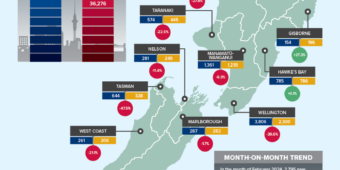Exempt from consent?
01 May 2014, LBP & Regulation, Prove Your Know How

Updated and detailed Schedule 1 guidance for exempt building work has been released, following the November 2013 Building Act amendment – here’s the lowdown.
Did you know some plumbing and drainlaying work must be carried out by an ‘authorised person’, such as a registered certified plumber or drainlayer, before it can be considered exempt building work? Or that, if you are removing a building element such as a chimney, roof or cladding from a building three storeys or less, there is a new exemption which may mean you do not require a building consent?
These changes were made when Schedule 1 of the Building Act 2004 (the Act) was amended in November 2013.
In March this year, The Ministry of Business, Innovation and Employment (MBIE) published new guidance to help keep you up to date with the changes.
The guidance concentrates on the 43 exemptions of Schedule 1 and is full of information and practical examples, with photos. It clarifies the type of work that is exempt and who can carry out this work.
It’s important that builders are aware of building work that is exempt from a building consent, as your clients will often rely on you to advise them.
Carrying out building work that is not exempt, without a building consent, is an offence and can incur a fine of up to $200,000 and a further fine of up to $10,000 per day if work continues.
Councils continue to have discretionary powers to grant exemptions for any proposed building work under exemption 2. However, they must be satisfied that the completed work is likely to comply with the Building Code, or there is minimal risk of it endangering people or property. If you want any work to be considered under this exemption, it is important to start discussions early with the local council.
What’s new?
A new section, relating to Schedule 1, has been added to the Act, while Schedule 1 itself has been amended to make the exemptions easier to use.
Section 42A:
This is a new section, which imposes some general conditions and limits on Schedule 1 exemptions and clarifies:
- What type of building work is exempt from requiring a building consent.
- Who can carry it out.
- What other conditions apply.
Schedule 1:
The scope of building work covered by Schedule 1 does not vary much from the previous version, which was introduced in December 2010. However, it has a new numbering system and has been divided into three parts, depending on who can carry out the work:
Part 1: Exempted building work lists work that anyone can carry out. It includes exemption 2, formerly Schedule 1(k), which gives territorial and regional authorities the discretion to exempt any building work from requiring a building consent.
Part 2: Sanitary plumbing and drainlaying carried out by person authorised under Plumbers, Gasfitters, and Drainlayers Act 2006.
Part 3: Building work for which design is carried out or reviewed by a chartered professional engineer.
Read the guidance
To find out more, read the guidance Building work that does not require a building consent – Building Act 2004 at www.dbh.govt.nz/bc-no-consent.
Remember – all building work must comply with the Building Code, regardless of whether it needs a building consent.
Other changes to the Act – Consumer Protection Measures
Once the regulations have been written, the new consumer protection measures will come into effect and builders will be required to provide clients with information about their credentials and enter into written contracts for work over a specified amount. These changes will make it easier for builders and homeowners to understand their rights and responsibilities. For a summary of the changes, go to www.dbh.govt.nz/bcupdate-149.
Illustrated Examples
Retaining walls
Building work in connection with a retaining wall that:
(a) retains not more than 1.5 metres depth of ground; and
(b) does not support any surcharge or any load additional to the load of that ground (for example, the load of vehicles).
This exemption allows you to build a retaining wall (which is any wall constructed to retain or support the surrounding ground) without needing to get a building consent as long as it does not retain more than 1.5 metres (vertically) of ground and it includes ground water drainage in relation to retaining walls.
This exemption does not apply to retaining walls that are subject to any additional load or surcharge, such as:
• vehicle driveways
• parking spaces
• buildings, or
• sloping ground above the top of the retaining wall.
Also refer to exemption 41 (retaining walls): this exemption covers building work relating to some retaining walls in rural zones as long as the design is carried out or reviewed by a chartered professional engineer.
ALERT:
If the ground above the top of the retaining wall is only gently sloping, this may not be considered as ‘surcharge’. To determine the impact of the sloping ground and its pressure on the stability of the proposed retaining wall, you may wish to seek professional advice; for example, from
a chartered professional engineer.
If there is a fall of 1 metre or more from the retaining wall, you may be required to install a safety barrier (under Building Code clause F4 – Safety from falling).
Factors to consider include the purpose/use of the retaining wall, how accessible it is, and whether it is frequented by young children.
Examples where this exemption could apply
- A builder plans to reconstruct an earthquake-damaged timber retaining wall that is less than 1.5 metres high. There is no surcharge on the retaining wall.
- A motel owner decides to terrace the motel’s uphill sloping section by building three 1.2 metre high concrete crib retaining walls to create three level platforms, each of which will be planted. As there will be sufficient horizontal separation between each of the retaining walls so that no surcharge load will be imposed on a lower wall, no building consent will be needed.
Examples where building consent is required
- An owner wishes to form a level platform for a garden below a neighbour’s driveway. To do this, she intends to construct a 1.2 metre high retaining wall. As the proposed retaining wall is subject to a surcharge from the neighbour’s vehicle driveway, it will require a building consent.
- A retaining wall ranges in height from 900 mm to 1.8 metres. The part of the retaining wall that exceeds the maximum allowable height of 1.5 metres will require a building consent.
Register to earn LBP Points Sign in






